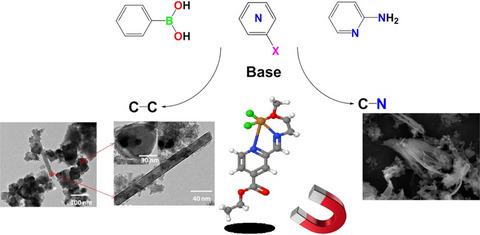当前位置:
X-MOL 学术
›
J. Am. Ceram. Soc.
›
论文详情
Our official English website, www.x-mol.net, welcomes your
feedback! (Note: you will need to create a separate account there.)
Hybrid organic‐inorganic Cu(II) iminoisonicotine@TiO2@Fe3O4 heterostructure as efficient catalyst for cross‐couplings
Journal of the American Ceramic Society ( IF 3.5 ) Pub Date : 2020-03-09 , DOI: 10.1111/jace.17098 Mohamed Shaker S. Adam 1, 2 , Farman Ullah 3 , Mohamed M. Makhlouf 4, 5
Journal of the American Ceramic Society ( IF 3.5 ) Pub Date : 2020-03-09 , DOI: 10.1111/jace.17098 Mohamed Shaker S. Adam 1, 2 , Farman Ullah 3 , Mohamed M. Makhlouf 4, 5
Affiliation

|
Two novel mononuclear copper (II) complex catalysts were synthesized from a new tridentate iminoisonicotine ligand (HL) by coordination with Cu(II) ion, with (CuL@TiO2@Fe3O4) and without (CuL) immobilization on TiO2‐coated nanoparticles of Fe3O4. The ester moiety on the back of the ligand was utilized for immobilization on nanoparticles of Fe3O4. Both ligand and CuL complex were fully characterized by using alternative spectral techniques (nuclear magnetic resonance, infrared, ultraviolet‐visible and mass spectroscopy, and elemental analyses). Different analytical techniques were used to identify the structural feature and morphology of the immobilized copper catalyst (CuL@TiO2@Fe3O4) shell‐shell‐core system. The structural analysis revealed that the catalyst system is composed of both agglomerated nanospheres and deformed nanorods. Both copper catalysts, immobilized CuL@TiO2@Fe3O4 and un‐immobilized CuL were studied in heterogeneous and homogeneous catalysis, respectively, for Suzuki‐Miyaura (C–C) and Buchwald‐Hartwig (C–N) cross‐coupling reactions of various heteroaryl halides. Both catalysts showed good catalytic potential under the controlled optimal reaction conditions. In contrast to the homogeneous catalyst (CuL), the heterogeneous catalyst (CuL@TiO2@Fe3O4) showed slightly better catalytic performance. The characteristic obtains supported the catalytic potential of the current samples. Reusability/recycling of both catalysts was also investigated in C–C cross‐coupling reactions. It was found that the homogeneous catalyst (CuL) could be only recycled up to three times, whereas the heterogeneous one (CuL@TiO2@Fe3O4) could be reused up to seven times with good efficiency.
中文翻译:

杂化有机-无机Cu(II)亚氨基异烟碱@ TiO2 @ Fe3O4异质结构作为交叉偶联的有效催化剂
通过与Cu(II)离子配位,(CuL @ TiO 2 @Fe 3 O 4)和不将(CuL)固定在TiO 2上,由Cu(II)离子配位,由新的三齿亚氨基异烟碱配体(HL)合成了两种新型单核铜(II)络合物催化剂。Fe 3 O 4包覆的纳米颗粒。配体背面的酯部分用于固定在Fe 3 O 4纳米颗粒上。配体和CuL络合物均通过使用其他光谱技术(核磁共振,红外,紫外可见光谱和质谱以及元素分析)进行了全面表征。使用不同的分析技术来确定固定化铜催化剂(CuL @ TiO 2 @Fe 3 O 4)壳-壳-核系统的结构特征和形态。结构分析表明,该催化剂体系由团聚的纳米球和变形的纳米棒组成。两种铜催化剂,固定化的CuL @ TiO 2 @Fe 3 O 4分别在Suzuki-Miyaura(CC)和Buchwald-Hartwig(CN)的各种杂芳基卤化物的交叉偶联反应的非均相和均相催化中研究了CuL和未固定的CuL。在控制的最佳反应条件下,两种催化剂均显示出良好的催化潜力。与均相催化剂(CuL)相比,非均相催化剂(CuL @ TiO 2 @Fe 3 O 4)表现出更好的催化性能。该特性获得了当前样品的催化潜力。在C–C交叉偶联反应中,还研究了两种催化剂的可重复使用性/再循环性。发现均相催化剂(CuL)最多只能循环使用三次,而异相催化剂(CuL @ TiO 2@Fe 3 O 4)可以高效重复使用多达七次。
更新日期:2020-03-09
中文翻译:

杂化有机-无机Cu(II)亚氨基异烟碱@ TiO2 @ Fe3O4异质结构作为交叉偶联的有效催化剂
通过与Cu(II)离子配位,(CuL @ TiO 2 @Fe 3 O 4)和不将(CuL)固定在TiO 2上,由Cu(II)离子配位,由新的三齿亚氨基异烟碱配体(HL)合成了两种新型单核铜(II)络合物催化剂。Fe 3 O 4包覆的纳米颗粒。配体背面的酯部分用于固定在Fe 3 O 4纳米颗粒上。配体和CuL络合物均通过使用其他光谱技术(核磁共振,红外,紫外可见光谱和质谱以及元素分析)进行了全面表征。使用不同的分析技术来确定固定化铜催化剂(CuL @ TiO 2 @Fe 3 O 4)壳-壳-核系统的结构特征和形态。结构分析表明,该催化剂体系由团聚的纳米球和变形的纳米棒组成。两种铜催化剂,固定化的CuL @ TiO 2 @Fe 3 O 4分别在Suzuki-Miyaura(CC)和Buchwald-Hartwig(CN)的各种杂芳基卤化物的交叉偶联反应的非均相和均相催化中研究了CuL和未固定的CuL。在控制的最佳反应条件下,两种催化剂均显示出良好的催化潜力。与均相催化剂(CuL)相比,非均相催化剂(CuL @ TiO 2 @Fe 3 O 4)表现出更好的催化性能。该特性获得了当前样品的催化潜力。在C–C交叉偶联反应中,还研究了两种催化剂的可重复使用性/再循环性。发现均相催化剂(CuL)最多只能循环使用三次,而异相催化剂(CuL @ TiO 2@Fe 3 O 4)可以高效重复使用多达七次。











































 京公网安备 11010802027423号
京公网安备 11010802027423号